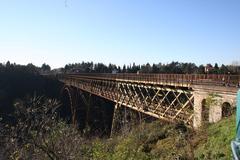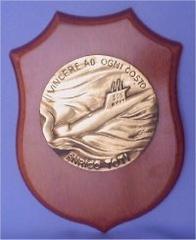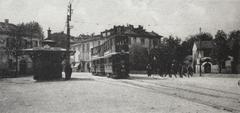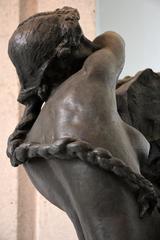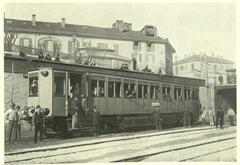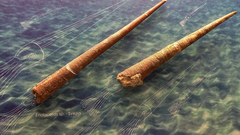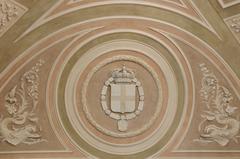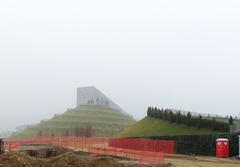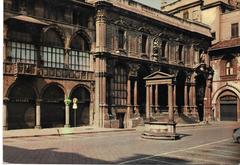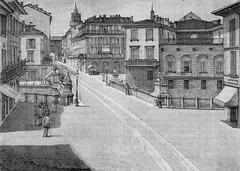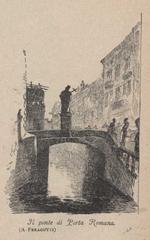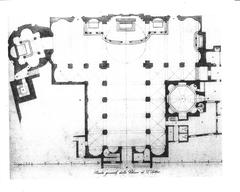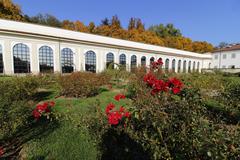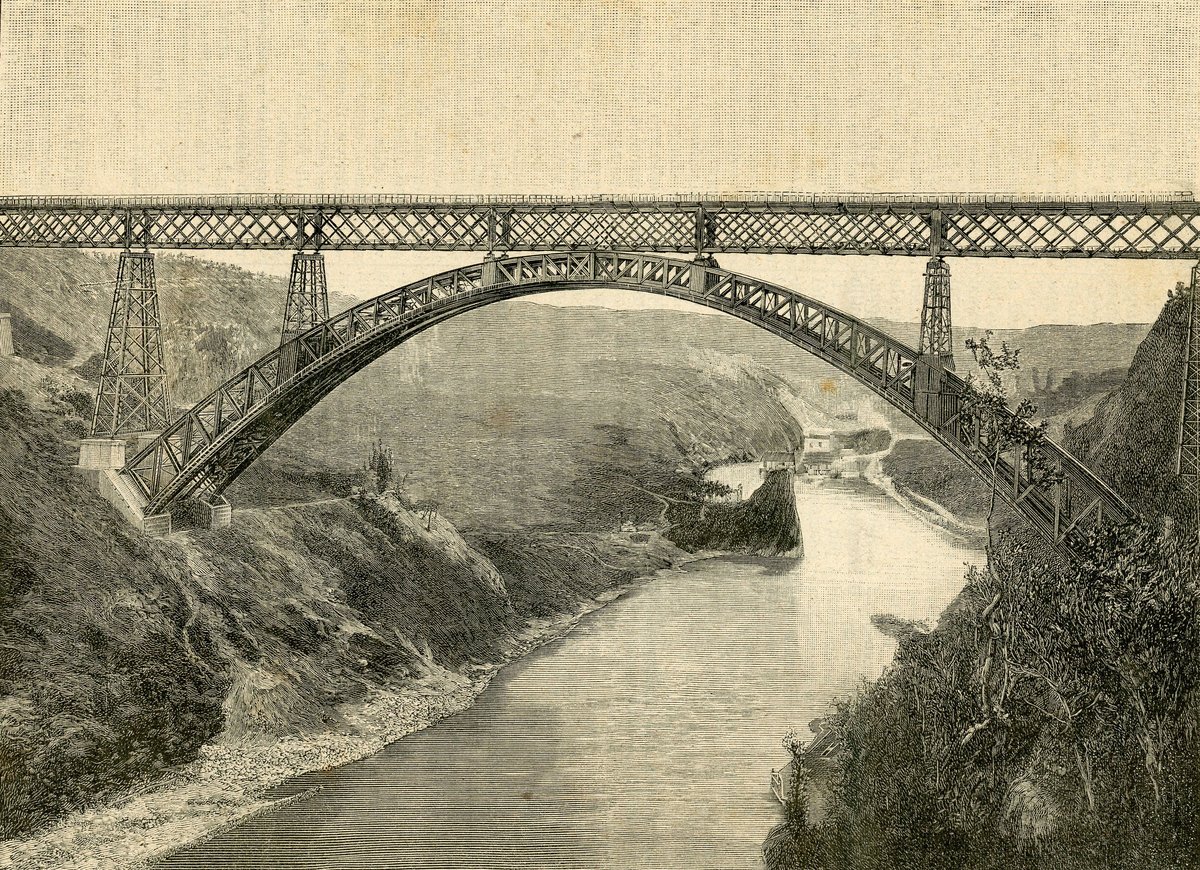
Comprehensive Guide to Visiting Ponte San Michele, Monza, Italy
Date: 18/08/2024
Introduction
Ponte San Michele, an extraordinary iron arch bridge nestled in the Lombardy region of Italy, stands as a shining example of Italy’s industrial heritage. Situated over the gorge of the Adda River, this bridge connects the towns of Paderno d’Adda and Calusco d’Adda, symbolizing both engineering prowess and historical significance. Constructed between 1887 and 1889, the bridge was designed by Swiss engineer Jules Röthlisberger, whose expertise in iron bridge construction culminated in this dual-purpose marvel (Museo e Tesoro del Duomo di Monza). The primary purpose of the bridge was to facilitate rail and road traffic, enhancing connectivity and promoting economic growth in the rapidly industrializing Italy of the late 19th century.
In contrast, Monza’s Ponte San Michele, a Romanesque bridge dating back to the 6th century, underscores an entirely different historical narrative. The bridge’s name is derived from the nearby Augustinian convent and church of Saint Michele, highlighting its cultural and religious significance throughout history. During the Middle Ages, this bridge played a crucial role in Monza’s defense and connectivity, contributing significantly to the city’s economic and strategic importance (Wikipedia). The architectural features of this pedestrian-only bridge, characterized by robust stone arches and Venetian influences, reflect the rich cultural exchanges that have shaped Italy’s history (Marble ND).
Table of Contents
- Introduction
- Origins and Construction
- Engineering Marvel
- Historical Significance
- Preservation and Restoration
- Visitor Information
- Visitor Experience
- Practical Information
- FAQ
- Conclusion
Origins and Construction
Ponte San Michele, also known as the San Michele Bridge, is an iconic structure located in the gorge of the Adda River, connecting the towns of Paderno d’Adda and Calusco d’Adda in the Lombardy region of Italy. This iron arch bridge is a significant example of Italian industrial archaeology and stands as a testament to the engineering prowess of the late 19th century.
The bridge was constructed between 1887 and 1889, during a period of rapid industrialization in Italy. It was designed by the Swiss engineer Jules Röthlisberger, who was renowned for his expertise in iron bridge construction. The project was commissioned by the Società Nazionale delle Officine di Savigliano, a prominent Italian engineering company of the time. The primary purpose of the bridge was to facilitate both rail and road traffic, thereby enhancing connectivity and promoting economic growth in the region.
Engineering Marvel
The San Michele Bridge is an engineering marvel, characterized by its impressive iron arch structure. It spans a length of 266 meters and rises to a height of over 100 meters above the Adda River. The bridge’s design incorporates a single iron arch, which supports the deck and allows for the passage of both rail and road traffic. This dual-purpose design was innovative for its time and demonstrated the versatility and strength of iron as a construction material.
The construction of the bridge involved the use of approximately 2,000 tons of iron, which was sourced from various parts of Europe. The iron components were prefabricated and then assembled on-site, a process that required meticulous planning and precision. The bridge’s construction was completed in just two years, a remarkable feat considering the technological limitations of the era.
Historical Significance
Ponte San Michele holds significant historical importance, both as a symbol of industrial progress and as a vital transportation link. During its early years, the bridge played a crucial role in facilitating the movement of goods and people between the provinces of Lecco and Bergamo. It contributed to the economic development of the region by providing a reliable and efficient means of transportation.
The bridge also holds cultural significance, as it represents the ingenuity and determination of the engineers and workers who built it. It stands as a monument to the industrial heritage of Italy and serves as a reminder of the country’s rich history of engineering and innovation.
Preservation and Restoration
Over the years, Ponte San Michele has undergone several preservation and restoration efforts to maintain its structural integrity and historical value. In the early 20th century, the bridge was reinforced to accommodate the increasing weight of modern vehicles and trains. More recently, in 2018, the bridge was temporarily closed for extensive restoration work to address issues related to corrosion and structural wear.
The restoration project, which was overseen by the Italian Ministry of Infrastructure and Transport, involved the replacement of corroded iron components, the application of protective coatings, and the reinforcement of the bridge’s foundations. The project aimed to preserve the bridge’s historical authenticity while ensuring its safety and functionality for future generations.
Visitor Information
- Ticket Prices: As of the latest updates, there is no fee required to walk or cycle across the bridge. However, guided tours may have associated costs. It’s advisable to check with local tour operators for more details.
- Visiting Hours: Ponte San Michele is open to pedestrians and cyclists year-round. However, it is advisable to check for any temporary closures or maintenance work before planning a visit. The best time to visit is during the spring and summer months when the weather is pleasant, and the surrounding landscape is in full bloom.
- Accessibility: The bridge is accessible to individuals with disabilities, but it is recommended to check specific accessibility features with local authorities or tour operators.
Visitor Experience
Today, Ponte San Michele is a popular tourist attraction, drawing visitors from around the world who come to admire its architectural beauty and historical significance. The bridge offers spectacular views of the Adda River and the surrounding landscape, making it a favorite spot for photography and sightseeing.
Visitors can walk across the bridge and explore the nearby towns of Paderno d’Adda and Calusco d’Adda, both of which offer a range of cultural and recreational activities. The area is also known for its scenic hiking and biking trails, which provide an opportunity to experience the natural beauty of the Lombardy region.
For those interested in the history and engineering of the bridge, guided tours are available, offering detailed insights into its construction and significance. These tours often include visits to the nearby industrial sites and museums, providing a comprehensive understanding of the region’s industrial heritage.
Practical Information
Ponte San Michele is accessible by car, train, and bicycle. The nearest train stations are Paderno-Robbiate and Calusco d’Adda, both of which are within walking distance of the bridge. For those traveling by car, there are parking facilities available in the nearby towns.
FAQ
- What are the visiting hours for Ponte San Michele? Ponte San Michele is open year-round to pedestrians and cyclists. It is advisable to check for any temporary closures or maintenance work before planning a visit.
- How much do tickets for Ponte San Michele cost? There is no fee required to walk or cycle across the bridge. Guided tours may have associated costs.
- Are there guided tours available at Ponte San Michele? Yes, guided tours are available and often include visits to nearby industrial sites and museums.
Conclusion
Ponte San Michele, whether seen through the lens of Lombardy’s industrial marvel or Monza’s historical Romanesque structure, offers a rich tapestry of Italy’s engineering and cultural heritage. The iron arch bridge over the Adda River symbolizes the ingenuity and determination of late 19th-century engineers like Jules Röthlisberger, playing a crucial role in the region’s economic development and connectivity. Its preservation and restoration efforts underscore its historical value and continued relevance in modern times.
In contrast, Monza’s Ponte San Michele stands as a silent witness to the city’s evolution from a Roman settlement to a medieval stronghold and finally a modern urban center. Its role in Monza’s development, from facilitating trade and communication to serving as a vital defense structure, highlights its enduring significance. Today, it remains a pedestrian-friendly bridge, seamlessly integrating historical preservation with modern urban planning.
For visitors, both bridges offer unique experiences, from guided tours that delve into their rich histories to scenic views perfect for photography. These structures not only connect different parts of their respective regions but also bridge the gap between the past and present, offering tangible links to Italy’s rich heritage. Whether you are a history enthusiast, an architecture aficionado, or a casual traveler, a visit to Ponte San Michele promises an enriching experience that transcends time (Lost Between Oceans, My Italian Diaries).
References
- Museo e Tesoro del Duomo di Monza, 2024, Museo e Tesoro del Duomo di Monza
- Wikipedia, 2024, Wikipedia
- Marble ND, 2024, Marble ND
- Lost Between Oceans, 2024, Lost Between Oceans
- My Italian Diaries, 2024, My Italian Diaries


